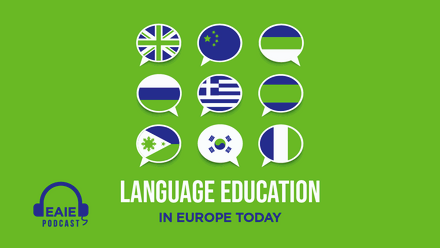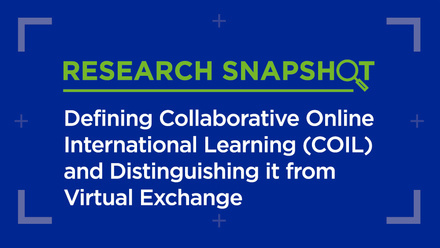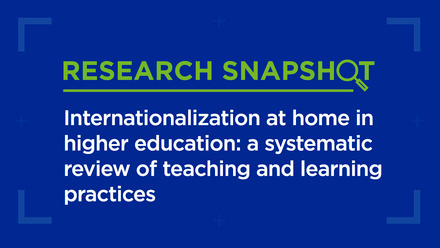Virtual education: implications for multilingual students

The impacts of COVID-19 on tertiary education are evident in nearly all regions of the world. Most higher education institutions have had to make immediate, unanticipated shifts in the delivery of instruction in an attempt to create a mode through which learning can continue without interruption. This has primarily been done by adopting remote learning as an alternative to face-to-face classroom instruction. Both instructors and students have suddenly been faced with the task of learning how to use a multitude of different education platforms and the many resources that can be incorporated into them.
For many international, multilingual students who attend higher education institutions where the dominant language of instruction is different from their first language, an additional hurdle is navigating how to communicate and comprehend content in a virtual classroom. Because communication strategies differ between online and in-person communication, multilingual students may find that the linguistic resources they are accustomed to using to communicate at their universities are quite different from those needed when communicating online.
The fundamentals
For students to have the opportunity to communicate in a remote learning environment, they must have access to the internet and the necessary technological resources. While unequal access to technology may ultimately create greater disparities in global equity in education, for the purposes of this topic it must be assumed that the multilingual students discussed here have adequate internet access. Additionally, students must have proficiency in using technology and the resources associated with remote learning, as well as motivation, time management skills and the ability to independently locate online educational resources.
The benefits
Online courses can provide opportunities and resources for multilingual students that might not be available in a traditional university setting. Many multilingual students may already use translanguaging when communicating with peers in non-academic, virtual settings such as social media and online messaging. Generally, translanguaging refers to the practice whereby multilingual individuals use their linguistic resources in any language in which they have proficiency to communicate and comprehend. For example, a student may read a blog in Mandarin but refer to the content of the blog in English in a tweet. If a student is already accustomed to using these practices in a non-academic setting, they could transfer these translanguaging skills to a remote academic environment.
Translanguaging refers to the practice whereby multilingual individuals use their linguistic resources in any language in which they have proficiency to communicate
Virtual education, particularly when asynchronous, can provide students with access to online resources for maximum comprehension of the subject matter, as well as the option to start, stop and replay lectures if necessary. This includes not only basic linguistic resources such as translation services – which are really only useful for students who have acquired academic linguistic skills in a ‘recognised’ and written language – but also videos, documents or websites in a language that might make the content more accessible. While this is also an option when students are learning on campus, in online courses they can immediately access resources in a language in which they might be more proficient, instead of waiting until the lecture is finished.
Furthermore, if instructors incorporate assignments that provide students with opportunities to use all four domains of a language (reading, writing, listening and speaking), it can allow students to fully participate in the course in a way that may not happen in a traditional class. For example, multilingual students may feel anxious about participating in a class discussion if they are concerned about their language proficiency. However, in an online course, they could be given the option of verbally responding to a prompt in a recorded video, which might lessen the anxiety associated with public speaking. With this in mind, it would be beneficial for tertiary instructors to receive training on strategies for teaching in a multilingual environment. This would not only be helpful for online learning but also for on-campus environments, particularly since mobility and technological advancements have internationalised higher education – a trend that is likely to continue.
The drawbacks
While remote learning can be beneficial for multilingual students, it may also have drawbacks. As well as the potential difficulties with online access and technological proficiency, different strategies are required for online communication from those used for in-person communication. In-person communication incorporates non-verbal cues and a degree of intercultural competence that may not develop in a virtual environment. This would be particularly pertinent for new students, who may learn communication strategies that are successful in online academia while not developing communication strategies that will help them once they return to a campus environment.
In-person communication incorporates non-verbal cues and a degree of intercultural competence that may not develop in a virtual environment
The unanticipated shift to online learning in higher education has created challenges for both students and instructors. International, multilingual students have the additional challenge of navigating a system that requires the use of new communication strategies to comprehend content in virtual classrooms. However, assuming that students have access to technological resources, this type of learning may have its advantages for students who are studying in a language other than their first language, such as opportunities to use translanguaging across online resources to effectively communicate and comprehend content.
To maximise the benefits of online learning in higher education, it would be valuable for instructors, particularly in tertiary institutions that have a large international student population, to receive training on teaching in multilingual environments. This will become even more valuable as mobility increases and technologies related to learning become more advanced.






